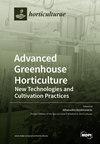Chemical Profiles and Antimicrobial Properties of Essential Oils from Orange, Pummelo, and Tangelo Cultivated in Greece
IF 3.1
3区 农林科学
Q1 HORTICULTURE
引用次数: 0
Abstract
In the framework of our studies on Citrus cultivars in Greece, the chemical composition of the essential oils (EOs) from the peels and leaves of orange, pummelo, and tangelo (mandarin × grapefruit hybrid) cultivated in Greece have been studied. All EOs have been analyzed through GC-MS, and a total of 47 and 87 metabolites were identified in the peels and leaves, respectively. These metabolites are classified into the chemical groups of terpenes, alcohols, aldehydes, esters, ketones, and organic acids. Limonene was the most abundant compound in the peel EOs. Moreover, bioactive polymethoxyflavones (PMFs) were isolated and structurally determined from the peels of orange and tangelo, highlighting them as a good potential source of natural PMFs. All EOs were evaluated for their antimicrobial activity against nine human pathogenic microorganisms (six bacteria and three fungi), showing an interesting profile. The EOs from the peels of all Citrus species exhibited a stronger antimicrobial activity compared to those from the leaves. The susceptibility of the assayed Gram-positive bacteria was observed to be greater than that of Gram-negative bacteria, while the fungi were also relatively less resistant than bacteria. The rootstock choice did not influence the EO profile of the fruit peel but exerted an influence on the chemical profile of the leaves.希腊栽培的橙子、柚子和唐吉坷德精油的化学成分和抗菌特性
在对希腊柑橘栽培品种进行研究的框架内,我们对希腊栽培的橙子、柚子和丹桂(柑橘 × 葡萄柚杂交品种)果皮和叶片中精油(EOs)的化学成分进行了研究。通过气相色谱-质谱(GC-MS)对所有精油进行了分析,在果皮和叶片中分别鉴定出 47 种和 87 种代谢物。这些代谢物分为萜烯、醇、醛、酯、酮和有机酸等化学组。柠檬烯是果皮环氧乙烷中含量最高的化合物。此外,还从橘子皮和柚子皮中分离出了具有生物活性的多甲氧基黄酮(PMFs),并确定了其结构,这表明它们是天然多甲氧基黄酮的良好潜在来源。评估了所有桉叶油对九种人类病原微生物(六种细菌和三种真菌)的抗菌活性,结果显示了有趣的特征。所有柑橘类果皮中的环氧乙烷都比叶子中的环氧乙烷具有更强的抗菌活性。据观察,被检测的革兰氏阳性细菌的敏感性高于革兰氏阴性细菌,而真菌的抗药性也相对低于细菌。根茎的选择对果皮的环氧乙烷含量没有影响,但对叶片的化学成分有影响。
本文章由计算机程序翻译,如有差异,请以英文原文为准。
求助全文
约1分钟内获得全文
求助全文

 求助内容:
求助内容: 应助结果提醒方式:
应助结果提醒方式:


